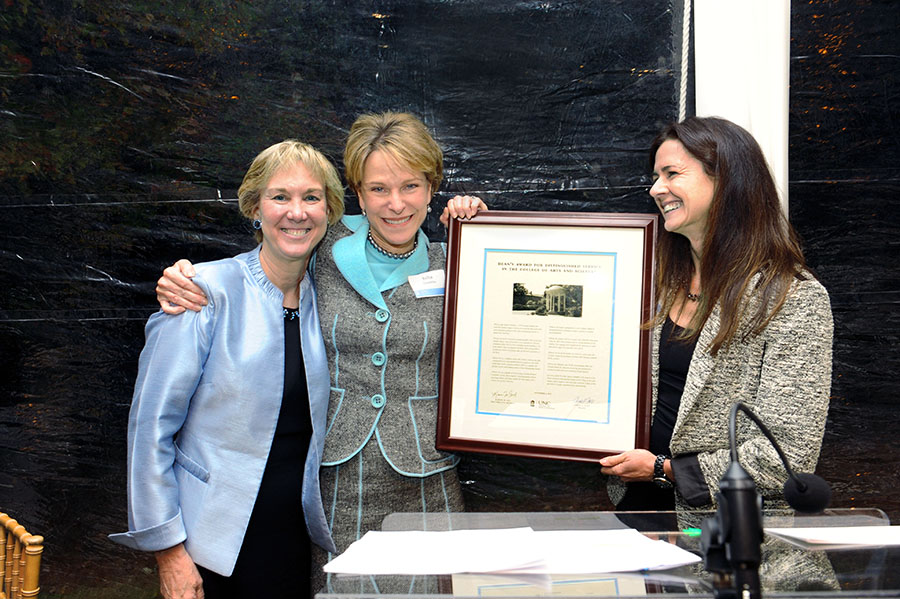
Her parents put a tennis racquet in her hands when she was 3, and at age 10 she won the city championship in the girls division for her age group. But when Barbara Osborne started junior high school in 1972, she found that sports teams were still only for boys. Osborne joined the Carolina faculty in the Department of Exercise and Sport Science in 1998, teaching in the sports administration specialization.
She earned her law degree at Boston College Law School while working at Brandeis University as associate athletic director. At Carolina, she is also an adjunct professor teaching sports law in the School of Law. This fall, she will participate in a Program in the Humanities symposium, “Sports in American Society.” Osborne spoke with the Gazette about her topic, “The (R)evolution of Women’s Sport.”
How did your childhood influence your career?
In a film I show for my “Women and Sports” class, one of the things that always gets me is how many of the changes in women’s sports are things I witnessed or lived. When I took the President’s Physical Fitness Test, a male P.E. teacher noticed I could run and invited me to practice with the boys’ track team. Title IX had been enacted by the time I reached high school, but the school didn’t have a girl’s cross-country team. So I grew up pre-Title IX when it was considered weird for a girl to want to be an athlete. The closest girls were supposed to get to the playing field was as cheerleaders for the boys.
So was it evolution or revolution?
Both. The defining cultural moment for women’s sports in the United States was Billy Jean King’s tennis match with Bobby Riggs in 1973, famously dubbed “The Battle of the Sexes.” That was when sports put a microscope on the issue of women’s equality in our greater society, and King understood that the momentum of the women’s rights movement at the time was riding on whether she won that match. Her victory was a very visible sign that women could compete equally with men.
The second defining moment came about in 1978, which was the year Title IX regulations became enforceable. It was the year I graduated from high school and the first time women were eligible to receive an athletic scholarship to attend college. I was lucky enough to be one of them.
Is the evolution complete?
In 1972, the year Title IX was enacted into law, there were only 294,000 girls participating in high school sports, compared to 3.6 million boys. The latest data from 2011 shows that the number of girls participating in high school sports had increased to almost 3.2 million and the number of boys to almost 4.5 million. Why the lag? Part of it goes back to a very strong cultural dependence on gender stereotypes. Female athletes are more accepted, but American society still defines an athlete as male. It is telling that media coverage of women’s sports is declining even as the number of women participating in sports continues to rise. Until the media say women’s sports are important, our culture is going to think of female athletes as second-class citizens.
But didn’t 13-year-old Mo’ne Davis, who graced the cover of Sports Illustrated this summer after pitching her team to victory in the Little League World Series, put to rest the insult “you throw like a girl”?
It was very interesting reading all the hype about Mo’ne Davis because little girls have always been successful in Little League. In fact, the very first litigation to gain opportunities for girls to play sports was in the 1960s, allowing girls to play Little League with boys. Pre-puberty, girls actually have a physiological advantage over boys, so there was nothing physiologically weird about excelling as she did. That fact that her excellence on the field became such a big story is evidence of the way we continue to think of girls as lesser athletes as boys. She is special and unique, to be sure, but she is not an aberration.
Why does it matter so much that women gain equal status in sports?
It is important if you see sports as a microcosm of our society. If you look at opportunities for men and women over their lifetime, girls benefit from sports in all the same ways that boys do – in the lessons learned on the field about teamwork and resilience, and off the field, about being a good winner or loser. Research shows that girls who participate in sports are more successful academically. They not only earn higher degrees, they are more likely to participate fulltime in the workforce and pursue non-traditional careers.
In fact, a recent study revealed that the majority of female CEOs of Fortune 500 companies were athletes. On the flip side, women who participate in sports are less likely to become unwed mothers or to use drugs or to develop breast cancer, heart disease or osteoporosis. That is why it matters – because there is clear evidence we will not gain gender equality in our society until we get it in sports.


